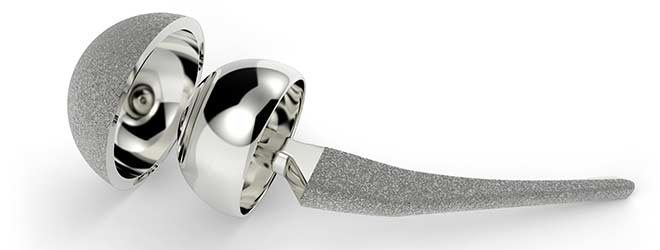Complications associated with Wright Hip Implants include infection, cobalt poisoning, soft tissue damage, device failure, and other serious side effects. Our law firm is currently working with some of the more experienced hip replacement lawyers, who are filing lawsuits and there are no legal fees until you receive a settlement or award. Feel free to call us toll-free or submit an online contact form.

Have You Suffered an Injury or Complication due to a
Wright Hip Implant?
Call Us Now For a Free Case Evaluation!
The FDA approved the Profemur device in 2001 followed by the Conserve device in 2009. View the FDA approval. Since their introduction to the market, it is estimated that more than 10,000 patients have received these hips. Lawsuits allege that premature failure associated with these hip devices does not make them an ideal product for younger patients and the modular necks may create a greater risk of bending.
Wright Hip Replacement Side Effects
The first warning signs that your hip implant might fail are usually pain, swelling, and difficulty walking. These outward symptoms may be manifestations of a more serious underlying injury like device fracture, dislocation, or failure. In some cases, these side effects become so severe that the patient implanted with these devices must undergo revision surgery. If you have been received a Profemur or Conserve hip replacement and suffered an injury you should contact a personal injury lawyer. A Wright lawyer can file a claim and begin working towards a settlement or award.
- Severe pain and inflammation
- Reduced mobility/ change in walk or gait
- Difficulty standing
- Muscle damage
- Growth of pseudotumors
- Bone loss
- Device loosening, fracture, or dislocation
Wright Hip Failure Rates

Two prominent joint registries have recorded high failure rates among these hip implants. In the Australian Orthopaedic Association’s 2009 Annual Report, the Wright Profemur Hip Replacement had a revision rate of 11.2% after just three years (i). Similarly, a study in the 8th Annual Report for The National Joint Registry for England and Wales found that the Wright Conserve Hip Replacement failed and required a revision surgery at a rate of 8.35% after five years (ii). These figures are alarming considering these implants should last 15 years or longer.
Government Investigation of Wright Medical Technology
In late 2007, Wright was subpoenaed by the U.S. Attorney’s Office for documents concerning the company’s “consulting and professional service agreements with orthopedic surgeons,” after allegations that the company was improperly persuading doctors to use its joint replacements. Later in 2010, the U.S. Attorney’s Office again filed a complaint that the company was continuing to improperly influence prescribing doctors to use its hip and knee products. The company settled this claim for $7.9 million. In 2012, the U.S. Attorney’s Office subpoenaed the company again seeking “requesting records and documentation relating to our PROFEMUR® series of hip replacement devices. The subpoena covers the period from January 1, 2000 to August 2, 2012” (iii).
Growing Number of Wright Lawsuits

The company is now facing an increasing number of claims that its all-metal hip implants caused patients to suffer severe injuries and eventually undergo corrective surgery. The number of lawsuits has caused the legal actions to be consolidated through the multidistrict litigation (MDL) process. The on-going litigation is referred to as In re: Wright Medical Technology, Inc., Conserve Hip Implant Products Liability Litigation, MDL-2329 and it is being heard in the United States District Court for the Northern District of Ohio. As of July 2013, there have been a total of 43 hip replacement lawsuits have joined in this MDL (iv).
In August 2011, Terrance Allore filed a Wright lawsuit after his hip failed. He alleged a manufacturing defect, design defect, failure to warn, misrepresentation, and negligence, among others. His wife is also suing for loss of consortium. On September 13, 2011, a Profemur lawsuit was filed by two Canadians from Nova Scotia. Ken Taylor received the hip implant in September 2007 and less than two years later the neck of his implant fractured. He then underwent revision surgery and a bone graft because proper growth was not occurring. The other plaintiff, Judy Rowter, claims that the threat of failure caused her to stop working. Most recently, on July 2, 2013, an Oregon man filed a lawsuit alleging that he had been implanted with Profemur and Conserve components but he suffered a fracture which required emergency revision surgery.
Do You Need a Hip Replacement Lawyer for your Conserve or Profemur Injuries?
 If you or a loved has been injured by one of these metal on metal devices, then you should talk to an attorney about your options. We work with experienced hip replacement lawyers, who can file a lawsuit on your behalf. There is no legal fee unless you receive a settlement or award for your injuries. Call us anytime at 1-800-992-6878 or fill out a contact form online for your free legal consultation.
If you or a loved has been injured by one of these metal on metal devices, then you should talk to an attorney about your options. We work with experienced hip replacement lawyers, who can file a lawsuit on your behalf. There is no legal fee unless you receive a settlement or award for your injuries. Call us anytime at 1-800-992-6878 or fill out a contact form online for your free legal consultation.
Sources:
- (i) Australian Orthopaedic Association, 2009 Annual Report.
https://aoanjrr.dmac.adelaide.edu.au/documents/10180/42728/Annual%20Report%202009?version=1.1&t=1349406243327 - (ii) National Joint Registry for England and Wales, April 2010 – March 2011.
http://www.njrcentre.org.uk/NjrCentre/Portals/0/Documents/NJR%208th%20Annual%20Report%202011.pdf - (iii) Securities and Exchange Commission, Form 10-Q 2012.
http://www.sec.gov/Archives/edgar/data/1137861/000113786112000048/wmgi630201210q.htm - (iv) Judicial Panel on Multidistrict Litigation Docket, July 10, 2013.
http://www.jpml.uscourts.gov/sites/jpml/files/Pending_MDL_Dockets_By_District-July-10-2013.pdf
